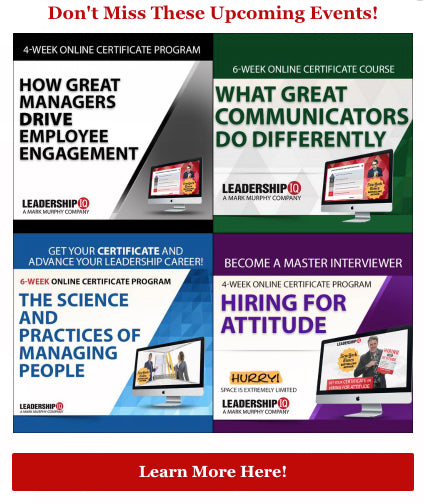Here's Why Employees Probably Don't Understand Your Vision
This article originally appeared on Forbes by Mark Murphy, Founder of Leadership IQ
When I go into organizations and I ask the employees “tell me why your team exists?” the most frequent response I hear is “I don’t really know.” This certainly isn’t great news, but it does help clarify one of my recent research findings that only 23% of employees say their leader always communicates their vision clearly. But what I find the most disturbing in all this is that when I give this feedback to the CEOs of these organizations, a large number of them say, “Wow, so nearly one third of my team is on board with my vision? That’s actually way better than I thought!”
Obviously, the extent to which employees understand your vision has an enormous impact on the outcome. These are, after all, the people who are going to be living that vision and making it happen. And yet, misunderstanding, misinterpretation and just flat out not knowing what the vision is all are far too common scenarios. Happily, there’s a fairly simple fix. If you want your employees all pulling together towards a shared vision, you have to make certain that they know what they are pulling for. And the best way to test that is to ask them. Specifically, you want to ask them to explain to you your vision, to actually tell you what they think it is. There are a couple of ways to go about this.
One method is incorporating the question into an employee survey. When I advise companies on conducting employee surveys, I often suggest including an open-ended question in the survey that asks: Write down our vision and what you think are the company’s three top strategic priorities in reaching that vision. This is an easy, immediate, and quick way to test if your employees understand where it is you’re trying to go and how you plan to get there.
If you’re not conducting a survey right now, and your team is small enough, you can conduct this test at your next staff meeting. Say you’ve got 8 employees sitting around a table with you. Give each of them a sheet of paper and say, “You all know we’re doing a big strategic overhaul in the department over the next 2 months that clearly changes our vision. Could you please write down for me what that new vision is and what you think the strategy is that we’re embarking upon?” The written responses you collect will quickly tell you whether or not you still have to sell the vision or whether you’ve got sufficient buy-in and understanding to achieve great results. Note that most initiatives that interrupt the status quo and ask folks to make a change require 70% workforce support to succeed.
Once you analyze the data, if you find that folks aren’t on board with your vision, you’ll need to take action. Otherwise it’s going to be like herding cats with employees all moving in different and wrong directions. Even if you have only 3 employees, if they’re all moving in the wrong directions, you’re not going to have the laser focus that you need and your odds of actually achieving your results will diminish significantly.
Work at creating a vision that actually inspires folks to pull together and act. The typical vision uses tired clichés and is just not that compelling, inspiring or unique. Examples of typical visions include: “Our vision is to be the premier provider of superior solutions by earning people’s trust” and “To be well recognized as a technology leader in the industry” The litmus test of whether or not a vision works is the question: would a reasonably satisfied high-performer at one of our competitors be sufficiently moved by our vision (understand it and trust its implementation) that they would quit their job and join us? If the answer is “no,” you need to better articulate your vision.
If you want people to be inspired by your vision, bought in to your vision, and to execute your vision, you must address these five points:
1: What does the end point look like? Let folks clearly see where it is you are asking them to go.
2: What data supports that direction? Reassure employees that you’re not completely off your rocker by providing data that shows you’ve really thought this through and that it’s grounded in possibility and reality.
3: What are the process steps to get us there? Explains the actions required to turn your vision into a reality.
- Who benefits from this and why do I care? Most people want to do something good and to believe their work is important. Understanding who benefits provides a sense of purpose.
- How do I contribute? Avoid abstract corporate speak here (words like synergy, core competencies, value proposition, etc.). Instead use plain, specific and highly understandable concrete language (words that you can picture in your mind). The more concrete the language in your vision, the more resonant your vision is and the harder it is to misinterpret.
You can’t be a leader without followers, but selling your vision is not about writing something that looks really nice on the boardroom wall that nobody else cares all that much about. All that matters is the extent to which your employees, the people who are going to be living this vision/strategy, understand it and understand what they specifically need to do to help you achieve that vision.
Mark Murphy is a NY Times bestselling author, founder of Leadership IQ, a leadership training speaker, and creator of the leadership styles assessment.







